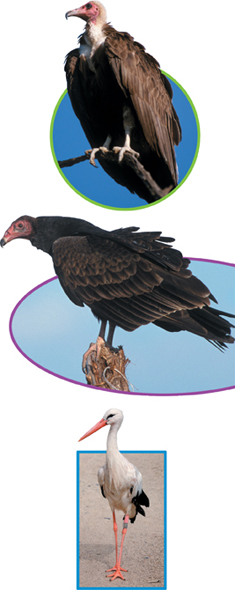DNA in Classification
 How are DNA sequences used in classification?
How are DNA sequences used in classification?
The examples of cladistic analysis we've discussed so far are based largely on physical characteristics like skeletons and teeth. But the goal of modern systematics is to understand the evolutionary relationships of all life on Earth—from bacteria to plants, snails, and apes. How can we devise hypotheses about the common ancestors of organisms that appear to have no physical similarities?
Genes as Derived Characters Remember that all organisms carry genetic information in their DNA passed on from earlier generations. A wide range of organisms share a number of genes and show important homologies that can be used to determine evolutionary relationships. For example, all eukaryotic cells have mitochondria, and all mitochondria have their own genes. Because all genes mutate over time, shared genes contain differences that can be treated as derived characters in cladistic analysis. For that reason, similarities and differences in DNA can be used to develop hypotheses about evolutionary relationships.  In general, the more derived genetic characters two species share, the more recently they shared a common ancestor and the more closely they are related in evolutionary terms.
In general, the more derived genetic characters two species share, the more recently they shared a common ancestor and the more closely they are related in evolutionary terms.
New Techniques Suggest New Trees The use of DNA characters in cladistic analysis has helped to make evolutionary trees more accurate. Consider, for example, the birds in Figure 18–11. The African vulture in the top photograph looks a lot like the American vulture in the middle photograph. Both were traditionally classified in the falcon clade. But American vultures have a peculiar behavior: When they get overheated, they urinate on their legs, relying on evaporation to cool them down. Storks share this behavior, while African vultures do not. Could the behavior be a clue to the real relationships between these birds?
Biologists solved the puzzle by analyzing DNA from all three species. Molecular analysis showed that the DNA from American vultures is more similar to the DNA of storks than to the DNA of African vultures. DNA evidence therefore suggests that American vultures and storks share a more recent common ancestor than the American and African vultures do. Molecular analysis is a powerful tool that is now routinely used by taxonomists to supplement data from anatomy and answer questions like these.

FIGURE 18–11 DNA and Classification Scientists use similarities in the genetic makeup of organisms to help determine classification. Traditionally African vultures and American vultures were classified together in the falcon family. But DNA analysis suggests that American vultures are actually more closely related to storks.

Table of Contents
- Formulas and Equations
- Applying Formulas and Equations
- Mean, Median, and Mode
- Estimation
- Using Measurements in Calculations
- Effects of Measurement Errors
- Accuracy
- Precision
- Comparing Accuracy and Precision
- Significant Figures
- Calculating With Significant Figures
- Scientific Notation
- Calculating With Scientific Notation
- Dimensional Analysis
- Applying Dimensional Analysis




